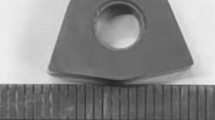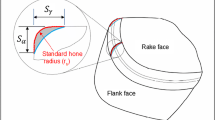Abstract
The cyclic utilization of coated cemented carbide inserts for turning of Inconel 718 was presented, which could be described as that the worn inserts should be given priority to repair rather than to reclaim the resources of W and Co. The assessment of the cyclic utilization was based on the fuzzy matter element (FME) according to the cutting performance including productivity, tool life, cutting forces, surface roughness, and wear mechanisms. From the productivity view accompanied with a rational tool life, the recommended cutting speed for coated cemented carbide and welding PCBN tools should be lower than 55 m/min and 92 m/min, respectively. With the cutting speed increasing, the amount of material removal of coated cemented carbide tools corresponding to the wear criterion of VB = 0.3 mm changed from 35 to 16.5 cm3, while that of welding PCBN tools varied from 25.5 to 18.6 cm3. Higher machining speed with the chamfered cutting edge for the welding PCBN tools enhanced the workpiece softening accompanied with better heat resistance, acquiring lower cutting force and better surface roughness. The dominant wear mechanisms of coated cemented carbide tools were notch wear under the lower cutting speed, while the adhesive wear became the leading factor when the speed was above 50 m/min. The welding PCBN tools showed severe wear pattern with adhesion, notching, and chip**. Based on the FME, the assessment of cutting performance demonstrated that the welding PCBN tools were better, which proved that the cyclic utilization was meaningful and improved the utilization efficiency of the worn cemented carbide inserts.









Similar content being viewed by others
Data availability
Not applicable.
References
Song XY, Zhao J (2008) Wear mechanism of coated carbide insert in turning of Inconel 718. Tool Eng 42:10–12
Thakur DG (2008) Study on the machinability characteristics of superalloy Inconel 718 during high speed turning. Mater Des 7:1–6
Zhu XL, Zhang S, Ding TC (2010) Statistical analysis of cutting forces in turning Inconel 718 with coated carbide tools. Adv Mater Res 135:96–101
Umbrello D (2013) Investigation of surface integrity in dry machining of Inconel 718. Int J Adv Manuf Technol 69:2183–2190
Konyashin I, Ries B, Lachmann F (2013) Gradient WC-Co hardmetals: theory and practice. Int J Refract Met Hard Mater 36:10–21
Rakesh M, Datta S, Mahapatra SS (2019) Effects of depth of cut during machining of Inconel 718 using uncoated WC tool. Mater Today Proc 18:3667–3675
Bhatt A, Attia H, Vargas R (2010) Wear mechanisms of WC coated and uncoated tools in finish turning of Inconel 718. Tribol Int 43:1113–1121
Prengel HG, **da PC, Wendt KH (2001) A new class of high performance PVD coatings for carbide cutting tools. Surf Coat Technol 139:25–34
Cantero JL, Alvarez JD, Miguelez MH (2013) Analysis of tool wear patterns in finishing turning of Inconel 718. Wear. 297:885–894
Devillez A, Schneider F, Dominiak S (2007) Cutting forces and wear in dry machining of Inconel718 with coated carbide tools. Wear. 262:931–942
Rahman M, Seah WKH, Teo TT (1997) The machinability of Inconel 718. J Mater Process Technol 63:199–204
**dal PC, Santhanam AT, Schleinkofer U (1999) Performance of PVD TiN, TiCN, and TiAlN coated cemented carbide tools in turning. Int J Refract Met Hard Mater 17:163–170
Grzesik W, Nieslony P, Habrat W (2018) Investigation of tool wear in the turning of Inconel 718 superalloy in terms of process performance and productivity enhancement. Tribol Int 118:337–343
Wang Y, Bin Z, Guigang Y (2019) Wear mechanisms of Ti(C7N3)-based cermet micro-drill and machining quality during ultra-high speed micro-drilling multi-layered PCB consisting of copper foil and glass fiber reinforced plastics. Ceram Int:4524578–4524593
Wang Y, Bin Z, Wang J, Wu Y, Huang C (2020) Effect of the progressive tool wear on surface topography and chip formation in micro-milling of Ti–6Al–4 V using Ti(C7N3)-based cermet micro-mill. Tribol Int 141:105900
Dudzinski D, Devillez A, Moufki A (2004) A review of developments towards dry and high speed machining of Inconel 718 alloy. Int J Mach Tools Manuf 44:439–456
Courbon C, Kramar D, Krajnik P (2009) Investigation of machining performance in high-pressure jet assisted turning of Inconel 718: an experimental study. Int J Mach Tools Manuf 49:1114–1125
Fujisaki K, Yokota H, Furashiro N (2009) Development of ultra-fine-grain binderless CBN tool for precision cutting of ferrous materials. J Mater Process Technol 209:5646–5652
Hao Y, Bin Z, Wang J, Chuanzhen H, Hongyu X, Zhenyu S, Xue K (2020) Design and fabrication of graded cBN tool materials through high temperature high pressure method. J Alloys Compd 832:154937
Rong XZ, Tsurumi T, Fukunaga O (2002) High-pressure sintering of CBN-TiN-Al composite for cutting tool application. Diam Relat Mater 11:280–286
Angseryd J, Elfwing M, Olsson E (2009) Detailed microstructure of a CBN based cutting tool material. Int J Refract Met Hard Mater 27:249–255
Jawahir IS, Brinksmeier E, Msaoubi R (2011) Surface integrity in material removal processes: Recent advances. Manuf Technol 60:603–626
Zhou JM, Bushlya V, Avdovic P (2012) Study of surface quality in high speed turning of Inconel 718 with uncoated and coated CBN tools. Int J Adv Manuf Technol 58:141–151
Bushlya V, Zhou J, Stahl JE (2012) Effect of cutting conditions on machinability of superalloy Inconel 718 during high speed turning with coated and uncoated PCBN tools. Procedia. 3:370–375
Pawade RS, Joshi SS, Brahmankar PK (2008) Effect of machining parameters and cutting edge geometry on surface integrity of high-speed turned Inconel 718. Int J Mach Tools Manuf 48:15–28
Arunachalam RM, Mannan MA, Spowage AC (2004) Residual stress and surface roughness when facing age hardened Inconel 718 with CBN and ceramic cutting tools. Int J Mach Tools Manuf 44:879–887
Zhou JM, Persson H, Msaobi R (2018) Surface characterization of AD730TM part produced in high speed turning with CBN tool. Procedia Eng 71:215–220
Anthony MA, Manohar M, Jeyapandiarajan P (2017) Tool wear assessment during machining of Inconel 718. Procedia Eng 174:1000–1008
Ji W, Liu XL, Yan FG (2014) Investigations of surface roughness with cutting speed and cooling in the wear process during turing GH4133 with PCBN tool. Key Eng Mater 590:258–263
Yang B, Chen GJ, Shi AH (2015) Review on technologies of short recycle process for scrap cemented carbide. Mater Rev 29:68–74
Zhou XH, Wang LM, Peng YJ (2016) Status and development of cemented carbide recycling industry in China. Cem Carbide 33:357–364
Funding
This project was supported by the National Science and Technology Major Project (2018YFB2002200 and 2018YFB2002205) and Major Program of Shandong Province Natural Science Foundation (ZR2018ZB0521 and ZR2018ZA0401).
Author information
Authors and Affiliations
Contributions
Hao Yun: methodology, formal analysis, writing—original draft.
Bin Zou: conceptualization, writing—review and editing.
Jun Wang: conceptualization.
Chuanzhen Huang: conceptualization.
Zhenyu Shi: data selection
Corresponding author
Ethics declarations
Ethical approval
Not applicable
Consent to participate
Not applicable
Consent to publish
Not applicable
Code availability
Not applicable
Competing interests
The authors declare that they have no competing interests.
Additional information
Publisher’s note
Springer Nature remains neutral with regard to jurisdictional claims in published maps and institutional affiliations.
Rights and permissions
About this article
Cite this article
Yun, H., Zou, B., Wang, J. et al. Assessment of cyclic utilization of coated cemented carbide inserts for turning of Inconel 718. Int J Adv Manuf Technol 112, 1583–1592 (2021). https://doi.org/10.1007/s00170-020-06520-2
Received:
Accepted:
Published:
Issue Date:
DOI: https://doi.org/10.1007/s00170-020-06520-2




